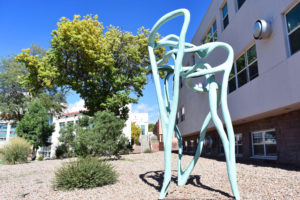
William Goodman’s Arabesque sculpture adjacent to Burris Hall on the Highlands University campus is part of a new public art installation.
Margaret McKinney/Highlands University
Las Vegas, N.M. – New Mexico Highlands is revitalizing its main campus through public artwork, thanks to the state’s Art in Public Places Program.
Ten artworks ranging from soaring outdoor sculptures to stoneware pottery and a series of bird paintings are being installed throughout the university.
“We wanted a variety of diverse artistic aesthetics,” said David Lobdell, chair of the Visual and Performing Arts Department at Highlands. “Consequently, we have a curvilinear sculpture, some geometric and angular sculptures, contemporary Native American painting and sculpture as well as a hanging reflective piece. We even have conceptual art in the telepoem booth, where one accesses poetry.”
Lobdell, a fine arts professor who played a lead role in the public art project, said art is the cornerstone of civilization and artistic expression is an intrinsic part of the human experience.
“I think this infusion of public art makes our university even more beautiful and unique,” said Ian Williamson, associate vice president of academic affairs. “The fundamental purpose of a university is to educate. I think art serves to open people’s minds, making it a gateway for education. Public art at a university allows for broad expression of ideas, which models self- expression for our students.”
Williamson said each building that received art had a committee to make initial decisions regarding art near or in their buildings.
“Collectively, the building committees reviewed hundreds of pieces of pre-approved art from the state. Each building had its own aesthetic characteristics that influenced selections,” said Williamson, who served on the Rodgers Hall committee and as a liaison with the state.
Williamson said it was important for there to be many voices in the art selection.
“A central committee reviewed the building committee recommendations and narrowed the pool, sending the choices back to the building committees for a final decision,” Williamson said.
The artworks include:
- Arabesque outdoor powder coated steel sculpture by William Goodman (Burris Hall)
- Telepoem Booth indoor interactive piece by Elizabeth Hellstern (Burris Hall)
- Lidded Jar wood-fired stoneware pottery by Daniel Johnston (Burris Hall)
- Do You See What I See outdoor steel sculpture by Tamara Robertson (Joe and Martha McCaffrey Historic Trolley Building)
- Five Keepers of the Land bird and moth painting series by Nanibah Chacon (Felix Martínez Building)
- Hummingbirds outdoor steel and enamel sculpture by Scot Ferguson (Lora Shields Building)
- Flying Peace outdoor stainless steel and stone sculpture by Kevin Box (Lora Shields Building)
- Thunderbirds outdoor galvanized steel, glass and brass sculpture by Peter Mangan (Student Center/Residence Halls)
- Moonsoon Rains indoor hanging acrylic modules piece by Joyce Crain (Student Center)
- Monolith Series outdoor corten steel sculptures by Stephen Shachtman (Rodgers Hall)
At Highlands, the Facilities Services Division is coordinating installation of the artworks, which is ongoing for the next several months.
“I’m thrilled by the way the artworks are transforming our campus,” said Sylvia Baca, Facilities and Planning director. “In my opinion, installing 10 artists’ work in a short timeframe has a more powerful and lasting impact on the campus.”
The stated goal of New Mexico’s Art in Public Places Program is to enrich New Mexico’s communities through innovative and diverse public art. The program is often referred to as the 1 Percent for the Arts Program because when a public building is built or renovated, 1 percent of the cost must be allocated for public art if the capital project exceeds $100,000.
New Mexico’s Art in Public Places Act dates back to 1986, when the state’s legislature passed the legislation and the governor signed it into law.
